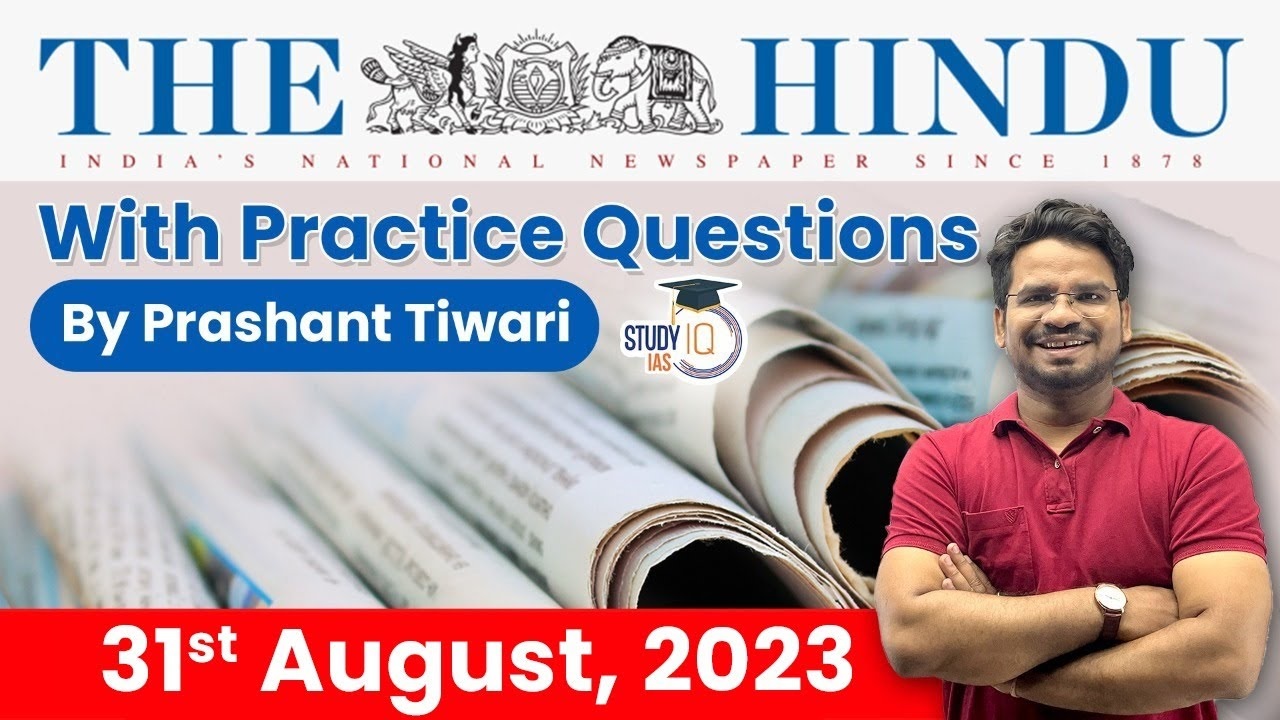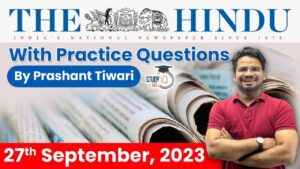The Hindu Newspaper Analysis for UPSC

The Hindu Newspaper Analysis 26 August 2023

The Hindu Editorial Today
- In compliance with the directives of the Cauvery Water Management Authority (CWMA), Karnataka has begun releasing water from its reservoirs to Tamil Nadu.
- The outflow from the Krishnaraja Sagar (KRS) reservoir in Mandya district into the Cauvery was at the rate of 4,398 cusecs (cubic feet per second) against an inflow of 2,300 cusecs on Wednesday morning.

River Cauvery (Kaveri):
- It is known as ‘Ponni’ in Tamil and is a sacred river of southern India.
- It rises on Brahmagiri Hill of the Western Ghats in southwestern Karnataka state, flows in a southeasterly direction through the states of Karnataka and Tamil Nadu, and descends the Eastern Ghats in a series of great falls and drains into Bay of Bengal through Pondicherry.
- Left Bank Tributary: Arkavathi, Hemavathi, Shimsa, and Harangi.
- Right Bank Tributary: Lakshmantirtha, Suvarnavati, Noyil, Bhavani, Kabini, and Amaravathi.
- The Dispute:
- As the river originates in Karnataka, flows through Tamil Nadu with major tributaries coming from Kerala and drains into the Bay of Bengal through Pondicherry the dispute therefore involves 3 states and one Union Territory.
- The genesis of the dispute is 150 years old and dates back to the two agreements of arbitration in 1892 and 1924 between the then Madras presidency and Mysore.
- It entailed the principle that the upper riparian state must obtain consent of lower riparian state for any construction activity viz. reservoir on the river Cauvery.
- The Cauvery water dispute between Karnataka and Tamil Nadu began in 1974 when Karnataka started diverting water without Tamil Nadu’s consent.

- Consider these facts: Artificial Intelligence (AI) is here to stay; AI possesses the capability to fundamentally change the way in which we work; AI can, by assimilation of data from multifarious online sources, present far more powerful (and seemingly creative) solutions than any human can; AI is a far greater force of either good or evil (or both). Given all this, AI needs to be regulated.
- Till recently, the greatest advances in the regulation of AI have been made in the European Union (EU), Brazil, Canada, Japan and now, China.
- Countries in the EU, Brazil and the United Kingdom (which shall be referred to hereafter as “western systems”) have adopted regulatory measures with differences which, on a closer study, are superficial. Regulations in Japan and China, however, are fundamentally different from the western system.

- The Indus Waters Treaty (IWT), brokered by the World Bank, which has again become a source of contention between India and Pakistan, considerably encapsulates the principle of equitable allocation rather than the principle of appreciable harm.
- Both India and Pakistan are granted exclusive rights to utilise the waters of the rivers allocated to them without harming others’ interests.
- Under the IWT, India has unrestricted use of the three eastern rivers (Ravi, Beas, and Sutlej), while Pakistan enjoys similar rights over the three western rivers (Indus, Jhelum, and Chenab).
- The core of the issue now between India and Pakistan involves the Kishanganga and Ratle hydroelectric power plants in India’s Jammu and Kashmir.

What is Kishanganga Hydroelectric Project?
- The Kishanganga project is located 5 km north of Bandipore in Jammu and Kashmir, India.
- It is a run-of-the-river project that includes a 37 m tall concrete-face rock-fill dam.
- It requires to divert water from the Kishanganga River through a tunnel to a power plant in the Jhelum River basin.
- It will have an installed capacity of 330 MW.
- The construction of this hydroelectric project began in 2007.
- Pakistan objected to the project arguing that it will affect the flow of the Kishanganga River (called the Neelum River in Pakistan).
- In 2013, The Hague’s Permanent Court of Arbitration (CoA) ruled that India could divert all the water with certain conditions.
- Ratle is an 850MW run-of-river hydroelectric power project being built on the Chenab River in the Kishtwar District of Jammu and Kashmir (J&K), India.

- The Bharatiya Nyaya Sanhita, 2023, through Clause 69, proposes to criminalise sex which is based on the promise to marry when there was no intention of fulfilling the same. While the clause also covers “deceit”-based sex beyond the promise to marry, the focus here is on cases where there is a promise to marry.
- Criminalising sex based on a promise to marry is not a new proposition; the judiciary has for long interpreted such cases as rape under Section 375 of the Indian Penal Code (IPC).Since a woman’s consent to sex is based on a man delivering a future promise to marry her, the breaking of such promises culminates in a rape trial.
- It is not difficult to foresee a possibility of misuse of Clause 69 by parents of women when they discover (through her pregnancy or otherwise) that their daughter had premarital sex.
- For instance, according to the Supreme Court, a man cannot be convicted for rape if the promise to marry has been broken because his parents were opposed to the wedlock (Deelip Singh v. State of Bihar, 2004).
- Similarly, if a woman has sex with a man from another caste based on a promise to marry, she is aware that marriage was never possible. This means that there was consent to sex irrespective of the promise of marriage (Uday v. State of Karnataka, 2003).

- The report, ‘State of Food Security and Nutrition in the World’ (SOFI) 2023, published last month, shows that while the cost of a healthy diet has increased in recent years in India, it is still the lowest among the BRICS nations (including the newly added six countries) and India’s neighbours.
- However, the share of people who are able to afford such a healthy diet is still low: India features at the bottom of that list since income levels are stagnant or going down.
- SOFI is published by the Food and Agriculture Organization and jointly produced with fellow United Nations agencies.
- A diet is considered too expensive if it costs more than 52% of a country’s average income. This percentage is based on data showing that people in low-income countries spend about 52% of their income on food. The percentage of people who cannot afford this diet is then calculated by using income distributions within a nation.
- About the State of Food Security and Nutrition in the World Report:
- It is an annual flagship report jointly prepared by the –
- Food and Agriculture Organisation of the United Nations (FAO),
- International Fund for Agricultural Development (IFAD),
- United Nations Children’s Fund (UNICEF),
- World Food Programme (WFP) and
- World Health Organisation (WHO)
- It aims to inform on progress towards ending hunger, achieving food security and improving nutrition and to provide an in-depth analysis of key challenges for achieving this goal in the context of the SDG.
- The report targets a wide audience, including policy-makers, international organisations, academic institutions and the general public.

- India enjoyed a positive image across 23 countries, with a median of 46% adults holding a favourable view of India, while a median of 34% held unfavourable views, according to an international survey conducted by the Pew Research Center, a Washington DC-based fact tank.
- The report, released ahead of the gathering of world leaders for the G-20 Summit in India in September, pointed to a variance between how Indians perceived Prime Minister Narendra Modi and India’s influence, and the views of adults in other countries.
- For instance, 79% of Indian respondents had a favourable view of Mr. Modi, with a majority 55% having a “very” favourable view.
- While perceptions of India skewed positive across the 23 countries surveyed, European attitudes toward India have turned negative over time, the report said.

- The Indian government has prohibited the export of white rice, levied a 20% exporty duty on par-boiled rice till October 15, and permitted the export of Basmati rice for contracts with value of $1,200 a tonne or above.
- India is the largest rice exporter globally with a 45% share in the world rice market. Overall rice exports in April-May of 2023 were 21.1% higher compared with the same period last financial year.
- For domestic consumers, though there is a slight increase in rice prices, in the long run, availability is secured and prices are not expected to spiral.
- The export of broken rice has been prohibited since last September. However, it is allowed on the basis of permission granted by the government to other countries to meet their food security needs and based on the request of their government.
- Trade sources add that Thailand expects nearly 25% lower production in 2023-2024; Myanmar has stopped raw rice exports; and the crop is said to be hit in Iraq and Iran as well.
- When the global rice market is bullish, it will absorb volume in high prices too. The government should look at classifying rice as common rice and speciality rice for export policy decisions rather than classifying as Basmati and non-Basmati.
- As many as 12 varieties of rice have Geographical Indication (GI) recognition and these should be insulated from general market interventions, suggests trade policy consultant S. Chandrasekaran.


 The Hindu Newspaper Analysis 6 October 2...
The Hindu Newspaper Analysis 6 October 2...
 The Hindu Newspaper Analysis 30 Septembe...
The Hindu Newspaper Analysis 30 Septembe...
 The Hindu Newspaper Analysis 27 Septembe...
The Hindu Newspaper Analysis 27 Septembe...





















